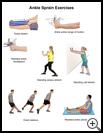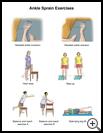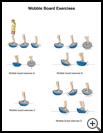
Ankle Sprain Exercises
Your healthcare provider may recommend exercises to help you heal. Talk to your healthcare provider or physical therapist about which exercises will best help you and how to do them correctly and safely.
As soon as it doesn’t hurt too much to put pressure on the ball of your foot, start stretching your ankle using the towel stretch. When this stretch is easy, try the other exercises.
- Towel stretch: Sit on a hard surface with your injured leg stretched out in front of you. Loop a towel around your toes and the ball of your foot and pull the towel toward your body keeping your leg straight. Hold this position for 15 to 30 seconds and then relax. Repeat 3 times.
- Standing calf stretch: Stand facing a wall with your hands on the wall at about eye level. Keep your injured leg back with your heel on the floor. Keep the other leg forward with the knee bent. Turn your back foot slightly inward (as if you were pigeon-toed). Slowly lean into the wall until you feel a stretch in the back of your calf. Hold the stretch for 15 to 30 seconds. Return to the starting position. Repeat 3 times. Do this exercise several times each day.
- Standing soleus stretch: Stand facing a wall with your hands on the wall at about chest height. Keep your injured leg back with your heel on the floor and the knee slightly bent. Turn your back foot slightly inward (as if you were pigeon-toed). Keep the other leg forward with the knee bent. Gently lean into the wall until you feel a stretch in the lower calf of your injured leg. Hold the stretch for 15 to 30 seconds. Return to the starting position. Repeat 3 times.
- Ankle range of motion: Sit or lie down with your legs straight and your knees pointing toward the ceiling. Point your toes on your injured side toward your nose, then away from your body. Point your toes in toward your other foot and then out away from your other foot. Finally, move the top of your foot in circles. Move only your foot and ankle. Don't move your leg. Repeat 10 times in each direction. Push hard in all directions.
- Resisted ankle dorsiflexion: Tie a knot in one end of the elastic tubing and place the knot between a shut door to hold it in place. Tie a loop in the other end of the tubing and put the foot on your injured side through the loop so that the tubing goes around the top of the foot. Sit facing the door with your injured leg straight out in front of you. Move away from the door until there is tension in the tubing. Keeping your leg straight, pull the top of your foot toward your body, stretching the tubing. Slowly return to the starting position. Do 2 sets of 15.
- Resisted ankle plantar flexion: Sit with your injured leg stretched out in front of you. Loop the tubing around the ball of your foot. Hold the ends of the tubing with both hands. Gently press the ball of your foot down and point your toes, stretching the tubing. Return to the starting position. Do 2 sets of 15.
- Resisted ankle inversion: Tie a knot in one end of the elastic tubing and place the knot between a shut door to hold it in place. Tie a loop in the other end of the tubing and put the foot of your injured side through the loop so that the tubing goes around the inside of your foot. Sit sideways to the door so your injured leg is straight out in front of you and closest to the door. Move away from the door until there is tension in the tubing. Keeping your leg straight, pull the inside your foot toward your other leg, stretching the tubing. Slowly return to the starting position. Avoid letting your kneecap turn inwards. Do 2 sets of 15.
- Resisted ankle eversion: Tie a knot in one end of the elastic tubing and place the knot between a shut door to hold it in place. Tie a loop in the other end of the tubing and put the foot of your injured side through the loop so that the tubing goes around the outside of your foot. Sit sideways to the door so your injured leg is straight out in front of you and farthest away from the door. Move away from the door until there is tension in the tubing. Keeping your leg straight, move the outside of your foot away from your other leg, stretching the tubing. Slowly return to the starting position. Avoid letting your kneecap turn inwards. Do 2 sets of 15.
You may do the following exercises when you can stand on your injured ankle without pain.
- Heel raise: Stand behind a chair or counter with both feet flat on the floor. Using the chair or counter as a support, rise up onto your toes and hold for 5 seconds. Then slowly lower yourself down without holding onto the support. (It's OK to keep holding onto the support if you need to.) When this exercise becomes less painful, try doing this exercise while you are standing on the injured leg only. Repeat 15 times. Do 2 sets of 15. Rest 30 seconds between sets.
- Clock balance exercise: Imagine a large clock on the floor. Stand with your injured foot in the middle of the clock and try to reach as far as you can toward the 12 o’clock position with your other foot. Gently tap the floor with your uninjured foot and then move to 3 o’clock, 6 o’clock, and 9 o’clock positions. Do this 5 times. Try not to lose your balance while doing this exercise.
- Step-up: Stand with the foot of your injured leg on a support that is 3 to 5 inches (8 to 13 centimeters) high. The support may be a small step or block of wood. Keep your other foot flat on the floor. Shift your weight onto the injured leg on the support. Straighten your injured leg as the other leg comes off the floor. Return to the starting position by bending your injured leg and slowly lowering your uninjured leg back to the floor. Do 3 sets of 15.
- Balance and reach exercises: Stand next to a chair with your injured leg farther from the chair. The chair will provide support if you need it. Stand on the foot of your injured leg and bend your knee slightly.
- With the hand that is farther away from the chair, reach forward in front of you by bending at the waist. Avoid bending your knee any more as you do this. Repeat this 15 times. To make the exercise more challenging, reach farther in front of you. Do 2 sets of 15.
- Reach the hand that is farther away from the chair across your body toward the chair. The farther you reach, the more challenging the exercise. Do 2 sets of 15.
- Side-lying leg lift: Lie on your uninjured side. Tighten the front thigh muscles on your injured leg and lift that leg 8 to 10 inches (20 to 25 centimeters) away from the other leg. Keep the leg straight and lower it slowly. Do 2 sets of 15.
If you have access to a wobble board, do the following exercises:
- Wobble board exercises:
Stand on a wobble board with your feet shoulder-width apart.
- Rock the board forward and backward 30 times, then side to side 30 times. Hold on to a chair if you need support.
- Rotate the wobble board around so that the edge of the board is always in contact with the floor. Do this 30 times in a clockwise and then a counterclockwise direction.
- Balance on the wobble board for as long as you can without letting the edges touch the floor. Try to do this for 2 minutes without touching the floor.
- Rotate the wobble board in clockwise and counterclockwise circles, but do not let the edge of the board touch the floor.
When you have mastered the wobble exercises standing on both legs, try repeating them while standing on just your injured leg. After you are able to do these exercises on one leg, try to do them with your eyes closed. Make sure you have something nearby to support you in case you lose your balance.
Last modified: 2019-07-30
Last reviewed: 2019-05-21



